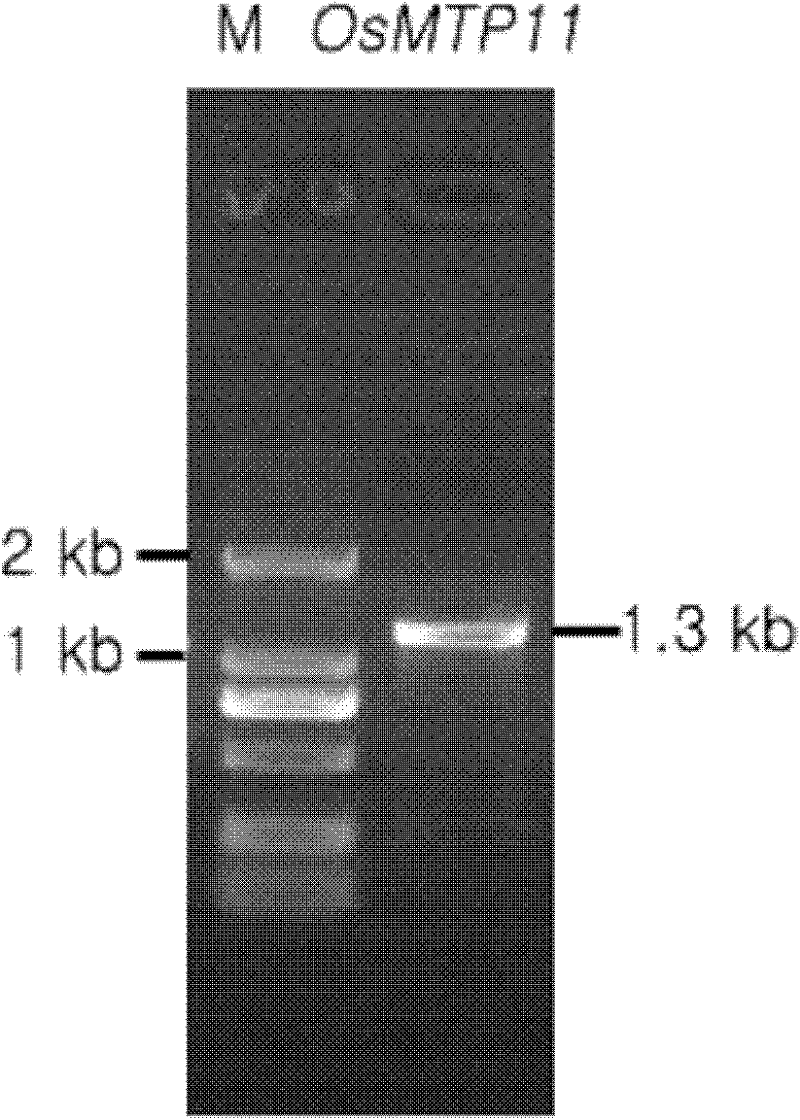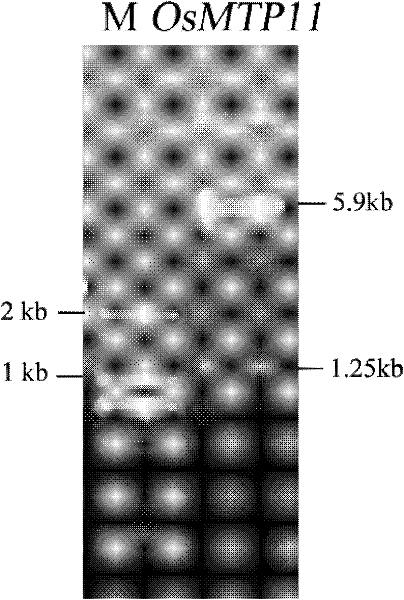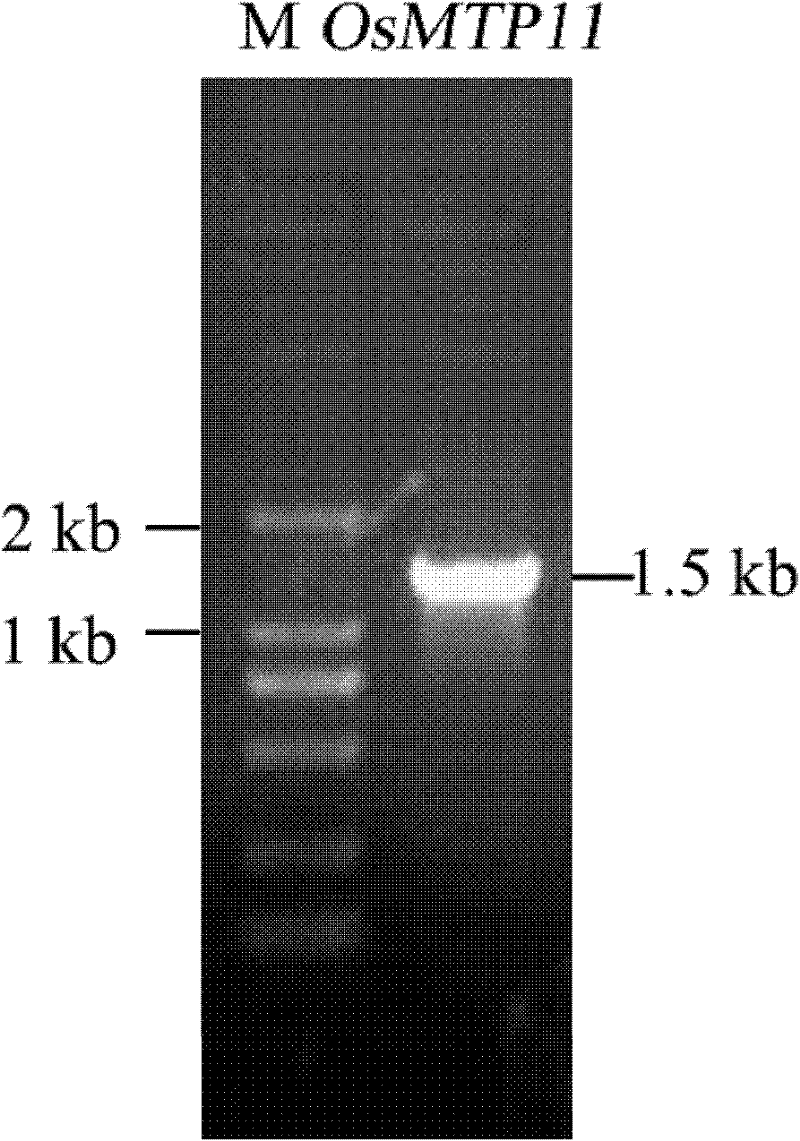A rice heavy metal-inducible tissue-specific promoter mtp11p and its application
A tissue-specific, heavy metal technology, applied in the field of plant genetic engineering, can solve problems such as the threat of rice production safety and heavy metal pollution
- Summary
- Abstract
- Description
- Claims
- Application Information
AI Technical Summary
Problems solved by technology
Method used
Image
Examples
Embodiment 1
[0033] Example 1: Cloning of the OsMTP11 gene
[0034] Take the leaves of rice Nipponbare seedlings, use TriZol Reagent (Invitrogen Company, its article number: 15596026) to extract the total RNA of the leaves, use agarose gel electrophoresis and ultraviolet spectrophotometer to detect the purity and amount of total RNA, and take 1 μg of total RNA For the initial reverse transcription reaction, the reverse transcriptase used is M-MLV (promega company, its product number: M1701), and the steps of the reverse transcription reaction refer to the instructions for use of the reverse transcriptase. Using the reverse transcription product as a template, design specific primers for the OsMTP11 gene:
[0035] M11F1 (5'TGACCGAGGGAGACTGCCCACC3')
[0036] M11R1 (5'CTGCTAAACTTAATACCAGTGG3'),
[0037] Use high-fidelity Taq enzyme for PCR. The PCR reaction system is: reverse transcription product 1 μl, 10xBuffer 5 μl, dNTP (each 2.5mM) 4 μl, M11F1 (10 μM) 1 μl, M11R1 (10 μM) 1 μl, Taq enzy...
Embodiment 2
[0038] Example 2: Genetic Transformation of Saccharomyces cerevisiae
[0039] Using the pGEM T recombinant plasmid containing the OsMTP11 gene cDNA in Example 1 as a template, design primer F1 (5'TTTCAGGGCG CCATGG ATGCGGCGGCGGTCGCGGG3') (the underline indicates the NcoI restriction site) and R1 (5'TCATGCTAGA CCATGG CTATTTTTCATGGGACAGAG3') (the underline indicates the NcoI restriction site). The reaction system is: pGEM T recombinant plasmid containing OsMTP11 gene cDNA (50ng / μl) 1μl, 10xBuffer 5μl, dNTP (each 2.5mM) 4μl, F1 (10μM) 1μl, R1 (10μM) 1μl, Taq enzyme (5U / μl) 1 μl, ddH 2O 37 μl. Mix well after adding the sample on ice. The reaction conditions are: 94°C for 5 min; 30 cycles of 94°C for 30 sec, 55°C for 30 sec, and 72°C for 80 sec; 72°C for 10 min. After the PCR reaction, a 1.25kb DNA fragment was obtained. The fragment was purified, and the In-fusion Advantage PCR Cloning Kit (Clontech, its catalog number: 639616) was used to insert it forward into the NcoI en...
Embodiment 3
[0047] Embodiment 3: Determination of yeast ion content
[0048] The formula of the yeast culture medium used is as follows:
[0049] Limit medium YNB (per 1L): yeast nitrogen source 1.7g, ammonium sulfate 5g, galactose 20g, dissolve to 1L, aliquot into 100mL, 115°C, 15min. The amount of agar powder added to the solid medium was 2% (g / mL).
[0050] Amino acid: L-His (240mg / 100mL): weigh 0.12g dissolved in 50mL sterilized ddH2O, filter sterilize
[0051] L-Leu (720mg / 100mL): weigh 0.36g dissolved in 50mL sterilized ddH2O, filter sterilize
[0052] L-Met (240mg / 100mL): weigh 0.12g dissolved in 50mL sterilized ddH2O, filter sterilize
[0053] Screening medium: 1L YNB + 8.3ml L-His (240mg / 100mL) + 8.3ml L-Leu (720mg / 100mL) + 8.3ml L-Met (240mg / 100mL).
[0054] The Saccharomyces cerevisiae BY4741 that was transferred with the expression vector pYES260 containing the OsMTP11 gene obtained in Example 2 was inoculated into the metal ion-free screening medium (YNB+L-His+L-Leu+L-Met...
PUM
 Login to View More
Login to View More Abstract
Description
Claims
Application Information
 Login to View More
Login to View More - R&D
- Intellectual Property
- Life Sciences
- Materials
- Tech Scout
- Unparalleled Data Quality
- Higher Quality Content
- 60% Fewer Hallucinations
Browse by: Latest US Patents, China's latest patents, Technical Efficacy Thesaurus, Application Domain, Technology Topic, Popular Technical Reports.
© 2025 PatSnap. All rights reserved.Legal|Privacy policy|Modern Slavery Act Transparency Statement|Sitemap|About US| Contact US: help@patsnap.com



